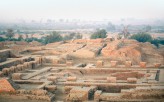Room 12 | India 2500 BC-AD 600 gallery
Explore the early development of Indian art, from the artefacts of the Indus Valley to the Hindu and Buddhist sculpture of north India and Gandhara.

Introduction
Religion has played a central role in Indian life and culture for at least four thousand years. Between 500 BC and AD 500 the major historic religions of Hinduism, Buddhism and Jainism were developing to maturity. Most surviving works of art from that period were inspired by their teachings.
 The Great Bath and Granary at Mohenjo-daro, Sind, Pakistan, 2600 – 1900 BC.
The Great Bath and Granary at Mohenjo-daro, Sind, Pakistan, 2600 – 1900 BC.
 Ruined Buddhist Stupa in the Khyber Pass region, c. AD 200 – 400.
Ruined Buddhist Stupa in the Khyber Pass region, c. AD 200 – 400.
 Massed group of Gandhara Buddha and Boddhisattva images collected at Loriyan Tangai (Peshawar Distri.
Massed group of Gandhara Buddha and Boddhisattva images collected at Loriyan Tangai (Peshawar Distri.
This gallery begins by showing the development of early Indian art, from the Indus Valley Civilization to the first flowering of Hindu and Buddhist sculpture in the Mathura region of North India. It also surveys the Buddhist art of the Gandhara region (north Pakistan and east Afghanistan). Strong Greco-Roman cultural influences in the north-west gave rise to a naturalistic style of sculpture which adapted classical models in depictions of the Buddha and his life.
See also
Notice
Objects may have since been removed or replaced from a gallery. Click into an individual object record to confirm whether or not an object is currently on display. Our object location data is usually updated on a monthly basis, so contact the Jameel Study Centre if you are planning to visit the museum to see a particular Eastern Art object.
© 2013 University of Oxford - Ashmolean Museum




